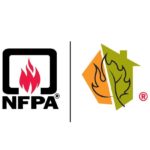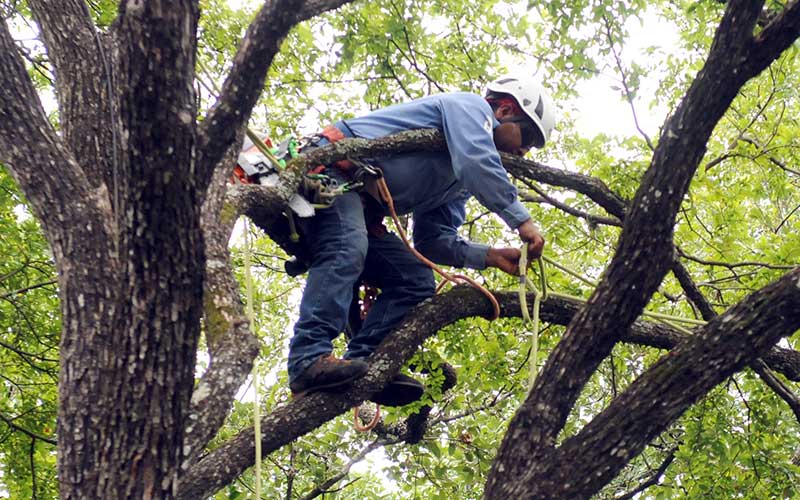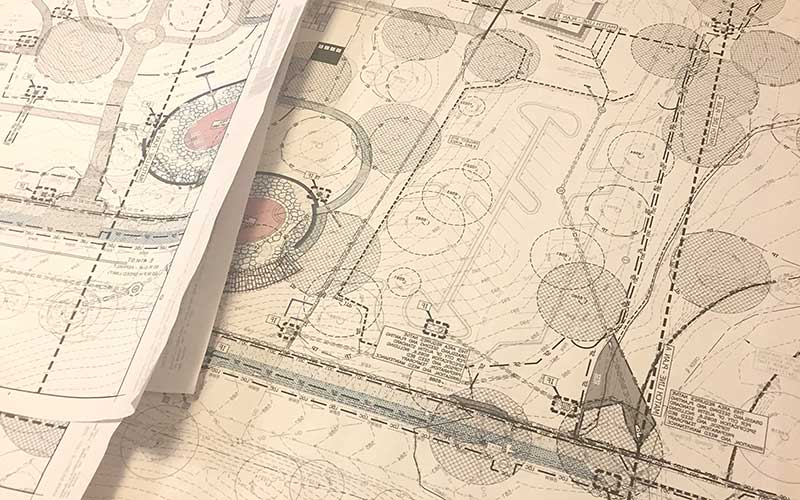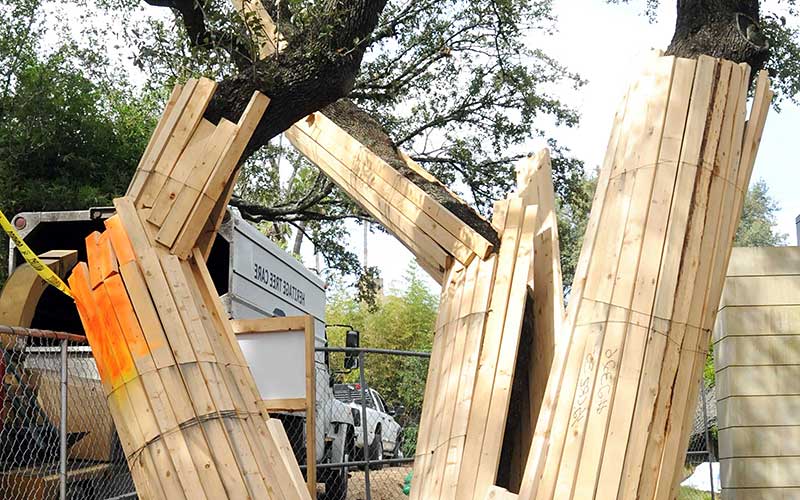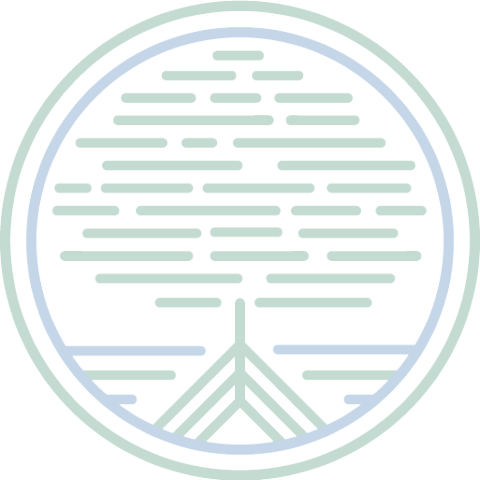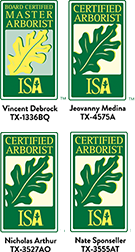Is Wildfire a Risk in Texas?
We love our trees in Central Texas. It’s one reason we live here. But as more and more people move to the edges of urban areas, we become part of the wildland/urban interface, which can be more susceptible to wildfires.
There have been several serious fires in our area in recent years. Texas is one of three states with the most homes at risk from forest fires.
Sometimes, those of us who live in wooded areas can’t help but feel a little nervous when the vegetation is dry, the humidity is low, and strong winds blow in from the south. What can we do to help protect our homes and communities?
How can homeowners protect themselves against wildfire?
A national program termed Firewise™ has been developed in recent years, which provides valuable information on how we can safeguard our homes with fire mitigation measures, including:
- Landscape choices.
- Fire-resistant home construction materials.
- Adequate driveways to allow emergency vehicle access.
Heritage Tree Care Certified Arborists have completed special training on the reduction of wildfire risk to homes, property, and natural areas. Their Wildfire Risk Reduction Qualification insures they have accurate knowledge to help property owners reduce wildfire risk.
We can explain how you can maintain fire-resistant landscaping by providing proper tree trimming, selective removal, and reducing undergrowth. We can offer suggestions on selecting less flammable trees and shrubs and picking the best location to reduce fire danger.
What is Firewise Landscaping?
Our goal is to create a buffer, which under most situations will help protect structures. You can picture it as a series of zones.
The area around a structure is known as the Home Ignition Zone. It extends a minimum of 100 feet on each side or as much as 200 feet in areas where the risk of wildfires is high.
Within this perimeter, are three zones as shown below:
Zone 1 is an area of 30 feet surrounding all structures, including decks, garages, etc.
Zone 2 encompasses 100 feet on all sides.
Zone 3 is 100 feet to the edge of your property.
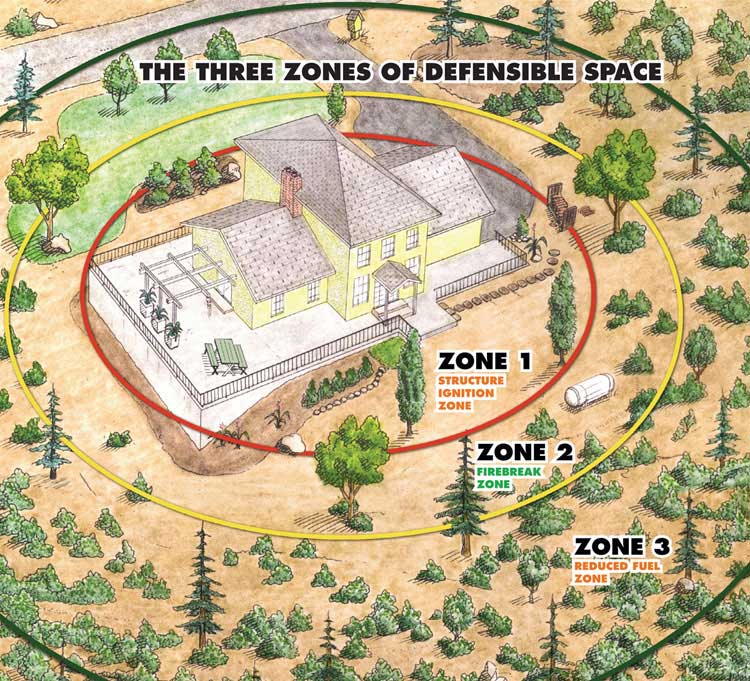
Photo credit: Firewise.org
Zone 1 has carefully spaced and well-watered plants. Within five feet of your house should be non-flammable covering; either concrete, pavers, gravel paths, or mulches, work well.
In the rest of this zone:
- Avoid flammable evergreen trees such as cedar, arborvitae, pines.
- Remove tree branches up to ten feet from the ground
- Vegetation should be low growing, widely spaced, and non-resinous. Rosemary, a favorite deer resistant landscape plant, is very resinous for example.
- Keep lawns well watered and mowed to a height four inches.
- Trim back trees that overhang too close to the house.
- Remove all fallen branches and forest litter.
- Our goal is to eliminate all ‘fire ladders’- vegetation that can allow a fire to spread from the ground to trees and structures.
Keep Zone 1 “Lean, Clean, and Green.” Lean means few flammable plants; clean means no accumulation of burnable debris; green means plants are healthy, irrigated, and green during fire season.
Zone 2 can include irrigated low-growing plants and widely spaced trees.
- Leave 20 feet between individual trees or 30 feet between clusters of trees.
- Remove any potential ‘fire ladders’; branches and shrubs that conduct fire to tree tops.
- Include a mixture of deciduous and coniferous trees.
- If you have meadow areas, including wildflowers, cut them back after the flowers seed.
Zone 3 extends from 100 feet to the boundaries of your property line.
- Thin trees so that their canopies do not touch.
- Clean-up significant accumulations of fallen branches and litter.
- Remove small shrubs and cedars that may grow between trees.
Don’t Remove All of Your Oak Trees
People often ask me whether oaks are fire-resistant and how many can be left in the landscape. Properly spaced oaks, with underlying shrubs removed, are a fire-safe tree species.
Of course, all vegetation can burn, but their tough, leathery leaves and thick bark are slow to ignite. Again, talk to an arborist before you have any trees removed. We can identify the healthiest specimens and tell you what pruning they may need.
Fire hazard reduction does not mean clear cutting a fire break. It does mean looking at what type of fire behavior is possible and what fuel it may ignite. – Vincent Debrock, Certfied Arborist & Co-owner
Where Do I Start to Create a Fire Safe Property?
- Begin your Firewise planning near your house. Having a non-flammable roof and gutters are an enormous benefit. Keep decks clean and spaces under them free of debris and flammable materials.
- Remove flammable plants such as juniper and other woody shrubs within five feet of your house and replace with ‘fire-smart’ plants.
- Don’t allow leaves and small branches to pile up in nooks and crannies around your house where an ember can easily ignite them.
- Trim any overhanging branches at least ten feet from your house.
- After you have cleaned up Zone 1, move out to Zones 2 and 3- thin out trees that are too close together, remove low limbs, underlying shrubs, and brush.
- Start your project close to your home, but start!
Call the Wildfire Risk Reduction Qualified Certified Arborists at Heritage Tree Care for expert help in caring for your trees and preparing your property to be Firewise.
Our Risk Assessment includes:
- Visual inspection of your property to analyze ways you can reduce structure ignition hazards
- Identifying wildfire risks within the home ignition zone
- Noting obvious areas of concern
- Recording aspects of wildfire risks
- Recommending steps to minimize risks
- Provide you with an oral or written report
Now is the time to get concrete recommendations to mitigate your wildfire risk.
For further information, I recommend these resources:
- The Texas Forest Service provides great information on protecting your home from forest
- This is a comprehensive guide to many aspects of wildfire preparedness. While focused on California, it’s got lots of helpful ideas.
